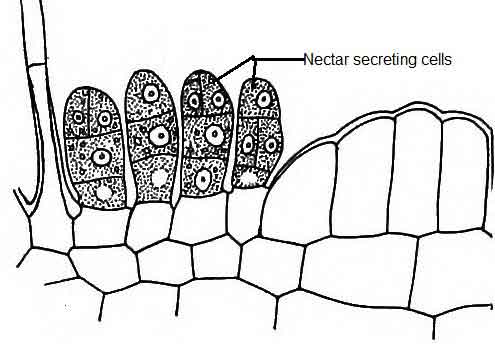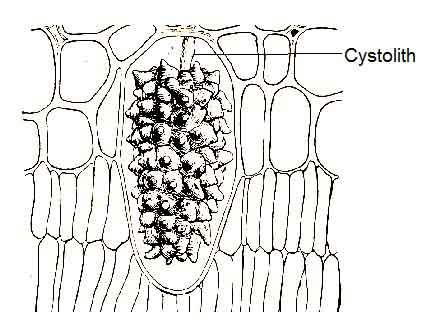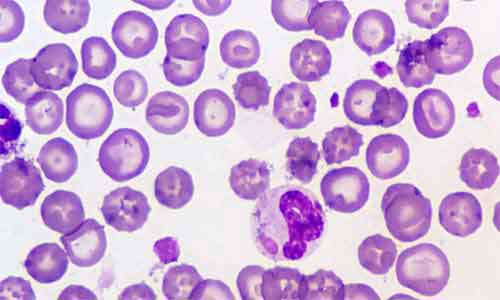The contents of the cell between the plasma membrane and nuclear envelope are known as cytoplasm. It is a gel-like clear substance that contains living and non-living materials such as water, enzymes, salts, organelles, and various organic molecules. Among them, organelles form the living inclusions, and non-living substances form cytoplasmic inclusions. These substances do not possess the metabolic activity and are not bounded by membranes. It is also known as ergastic substances. O. F. Müller first observed these structures in 1786. The cytoplasmic inclusions or non-living cell contents may be classified into the following three main groups:
- 1. Reserved Products
- 2. Secretory Products
- 3. Excretory Products
Reserved Products
The reserved products are formed by various metabolic activities of the cells. These materials are produced and stored in that particular cell. The reserved products are of the following three main groups:
- Carbohydrate
- Proteins
- Fats or oils
Carbohydrates
Carbohydrates are neutral organic compounds that are made up of carbon(C), hydrogen (H), and oxygen (O) ions. Hydrogen and oxygen remain in the same proportion as in water that is 2:1 (H2O). Carbohydrates are classified into three types, namely monosaccharide, which contains one molecule of sugar, oligosaccharide, which contains 2-10 molecules of sugars and polysaccharide, which contains more than ten molecules of sugars. Glucose, fructose, galactose, etc. are monosaccharides; maltose, lactose, sucrose are disaccharides (oligosaccharide). These monosaccharides and disaccharides are all soluble sugars that remain dissolved in the cytoplasm. Starch, cellulose, and hemicelluloses are insoluble polysaccharides found in plant cells. Glycogen is a soluble polysaccharide found in animal cells.

Starch (C6H10O5)n: In the cytoplasm, starch remains scattered in the form of particles. These particles are called starch grains. They may be round, oval (potato), polygonal(maize) or spherical(pea) in shape. The grains are stratified because starch is deposited in layers around a definite point known as hilum. When the layers are deposited in such a way that the hilum remains on one side as in potato, the grain is said to be eccentric when the hilum remains at the center as in pea; the grain is said to be concentric. Starch grain may be simple when they occur singly or compound when they occur together in a solid group.


Image showing different types starch grains
Glycogen (C6H10O5)n: It is a multi-branched polysaccharide that is mainly found in the liver and muscle cells of the animal body. Hence, it is also known as animal starch. Generally, it is present in the cytoplasm in between mitochondria and endoplasmic reticulum in the form of particles. In the liver cells, two types of particles are found, such as smaller β-particles and larger rosette-like α-particles. It is also found in blue-green algae, fungi, and in some lower plants.

Chemical structure Glycogen
Inulin(C6H10O5)n: It is a polysaccharide carbohydrate that is found in many roots of composite plants. It yields fructose on hydrolysis. It is colorless, tasteless, white amorphous powder or crystals and soluble in water.
You might also read: Details of Carbohydrate: Definition, Classification and Its Functions
Protein
It is an organic compound which is generally made up of carbon(C), hydrogen (H), oxygen (O) and nitrogen (N), sometimes it also contains sulfur (S) and phosphorus(P). These elements form amino acids, the unit of protein. Proteins are classified into three groups, namely pure protein, conjugated protein, and derived protein. The cell membrane, protoplasm, nucleoplasm, and the cytoplasmic organelles are made up of protein. Some proteins are soluble in water, and some are insoluble in water. In insoluble protein, particles remain scattered within the cytoplasm, which is known as proteid grains.
In certain plants, proteid grains are called aleurone grains. They are found to occur in several seeds. Aleurone grains are larger and are found in those seeds that contain less starch, as in castor. These grains are relatively small and are found in those seeds that contain abundant starch, as in maize. It is oval or spherical in shape and consists of two parts, namely a proteinaceous crystal-like polygonal body, called crystalloid, and a rounded mineral body, called globoid. The smaller grains are devoid of globoid.

Image showing aleurone grain (castor bean)
Fats or oils
Fats are an ester of fatty acids and glycerol. Both are made up of carbon, hydrogen, and oxygen. At room temperature, some fats remain solid and others in liquid forms, which are known as oils. In animals, fats are mostly stored in fat cells of connective tissue. The big fat droplets occupy almost the whole of the cell. The cytoplasm and nucleus are pushed out to one side. In plants, fats are generally stored in the seeds.
Secretory Products
Various products like nectar, coloring material (pigments), hormones and enzymes, etc. which are secreted by the cells, are called secretory products.
Nectar: It is secreted by a special type of glands, called nectaries, present in many flowers. It attracts the insects for pollination.

Image showing nectar secreting cells
Coloring materials: These are produced by the plant cell. The coloring materials include chloroplasts, chromoplasts, and anthocyanins, etc. These are essentials in the process of photosynthesis. They also provide coloration to various organs of the plant.
RBC of the animal contains hemoglobin. It is an iron-containing pigment. Melanin is a brown to black pigment present in the skin, eye, etc.
Hormones and enzymes: These are organic compounds that are secreted by the animal and plant cells. They have a profound influence on the metabolism, growth, and development of animal and plant bodies.
Zymogen granules: Zymogen granules are inactive precursors of some digestive enzymes. They are secreted from glandular cells. They are large, spherical, and homogeneously dense granules with a single membrane. These granules are present in the cytoplasm in between Golgi bodies and the free surface of the cell. Its average diameter is 0.1-0.5 µ and generally found in the secretory cells like acinar cells of the pancreas and chief cells of the stomach. In the pancreatic acinar cells, protein is first synthesized directly into the cisternae of the endoplasmic reticulum(ER). Zymogen accumulates in the Golgi bodies, where it is concentrated and forms granules. This process is known as packaging. Zymogen granules then bud off as secretory granules. They are transported to the cell membrane and eliminate them into the external environment.
Excretory Products
Various harmful products are formed in the cell due to metabolism. These are not secreted but stored in the cytoplasm of the cell. These are known as excretory products of the cell. These products are useful to mankind.
Mineral crystals
The common forms of crystal secreted by plant cells are made up of silica, calcium carbonate, and calcium oxalate. Calcium oxalate is the most common and is widely distributed among the various plants.
(i) Cystolith: It is an outgrowth of the epidermal cell wall; Calcium carbonate occurs as a large mass of small crystals in many plants leaves. The whole crystalline mass looks like a bunch of grapes suspended from a stalk from the upper epidermis. It is known as cystolith. Cystoliths are found in certain plant families, such as Acanthaceae, Urticaceae, Cannabaceae, Moraceae (Ficus elastica), etc.

Image showing systolith
(ii) Raphides: Mainly calcium oxalate occurs as aggregates of crystals in the form of raphides. The bag-like specialized cells where these are formed are known as idioblasts. These may be seen singly or in a bundle. The crystals are needle-like structures. They are commonly seen in water hyacinth (Eichhornia crassipes), Colocasia (Araceae), leaves of Bougainvillea (Nyctaginaceae), and in many other plants.

Image showing Raphides
Tannins
These are a group of complex compounds; it commonly occurs in single isolated cells. These are abundant in the bark caves and many unripe fruits. Tea leaves contain about 15% tannins.
Essentials oils
These are present in oil glands, which are found in the leaves of sacred basil or tulsi (Ocimum tenuiflorum), lemon, petals of the rose, etc. The common essential oils are sandalwood oil, rose oil, and clove oil.
Resins
Resins are yellowish solids, insoluble in water, but soluble in alcohol. They are found in the stems of conifers and sal trees ( Shorea robusta).
Gums
It is an amorphous colloid and consists largely of decomposition products of cellulose or other carbohydrates of the cell wall. They occur in mixtures with resins and complex carbohydrates. Common examples are camphor(Cinnamomum camphora), goggul(Commiphora wightii), gum Arabic(Acacia species), gum tragocanth ( Astragalus), etc.
Latex
It is generally milky, viscous colloidal substances, found in latex cells and latex vessels. It is often found in Indian rubber plant (Ficus elastica), para rubber tree (Hevea brasiliensis) and calotropis (milkweeds: Apocynaceae). It is also found in opium poppy (Papaver somniferum).

Image showing Latex vessels
Alkaloids
These are complex nitrogenous substances and are present in the seeds and roots of some plants. These are intensely bitter, and some of them are poisonous. The caffeine of coffee and tea, nicotine of tobacco, quinine of cinchona(Rubiaceae), morphine of opium poppy, and strychnine of Strychnine tree (Strychnos nux-vomica) are the best examples of alkaloids.
Some Functions of Cytoplasmic Inclusions
- These substances aid the organism in defense.
- It does maintenance of the cellular structure.
- It helps to store various materials.
- Some inclusions such as hormones, enzymes, etc. influence the metabolism, growth, and development of animal and plant bodies.
- Inclusions like nectar attract the insects for pollination.
- Tannins of plants play a role in protection from predation and might help in regulating plant growth.
- The resin of plants protects the plant from pathogens and insects.
Concluding Remarks
The cytoplasm is a gel-like, highly viscous substance that is composed of three types of structure, including the cytoplasmic matrix, the cytoplasmic organelles, and the cytoplasmic inclusions. They are enclosed within the cell membrane, and they contain about 85% water, 10-15% proteins, 2-4% lipids, inorganic salts, nucleic acids, and carbohydrates in a small amount. Most of the metabolic activities occur within the cytoplasm. During metabolic activities, some non-living substances such as nutrients, pigments, hormones, enzymes, etc. are produced. These products form the cytoplasmic inclusions and perform various functions.

